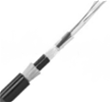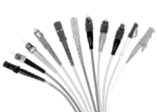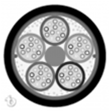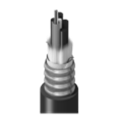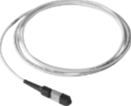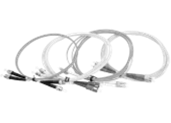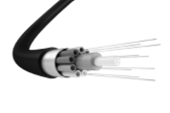1. Introduction
In the intricate world of fiber optic installations, where speed, reliability, and performance reign supreme, the concept of pre-terminated fiber optic assemblies emerges as a beacon of efficiency and convenience. Imagine a solution that arrives ready for deployment, eliminating the complexities of on-site terminations and accelerating the installation process. This solution is none other than the pre-terminated fiber optic assembly – a complete, factory-terminated cable system that offers a multitude of advantages for diverse networking needs.
1.1 Defining Pre-Terminated Fiber Optic Assemblies
At its core, a pre-terminated fiber optic assembly is a comprehensive cable solution designed to streamline the installation process. These assemblies come fully equipped with connectors already terminated on both ends, and in many cases, they encompass additional components like splitters, fan-out kits, and adapter panels. Crucially, these assemblies are meticulously manufactured, tested, and terminated within controlled environments before being deployed to the field.
1.2 The advantages of pre-terminated assemblies
The advantages offered by pre-terminated fiber optic assemblies are manifold. A primary benefit lies in their plug-and-play nature, significantly reducing the need for on-site terminations and intricate splicing. This not only expedites the installation timeline but also translates to reduced labor costs. The reliability of these assemblies is further bolstered by the fact that factory terminations occur in controlled environments using specialized equipment, ensuring consistent and high-quality terminations.
Beyond their ease of installation and consistent quality, pre-terminated assemblies deliver exceptional performance and reliability. Rigorous testing and quality checks guarantee optimal signal integrity and performance, while the elimination of field terminations reduces the risk of errors and signal loss due to poor terminations.
In the subsequent sections of this article, we will delve deeper into the features, benefits, applications, and considerations associated with pre-terminated fiber optic assemblies. By the end of this journey, you'll be equipped with a comprehensive understanding of how these assemblies can revolutionize fiber optic installations across diverse sectors.
Navigating jacket types for fiber-optic installation

2. Navigating jacket types
When it comes to fiber optic installations, the journey starts with understanding the diverse jacket types that cloak these intricate communication lifelines. Each jacket is meticulously designed to serve a specific purpose, offering protection and resilience tailored to the environment it encounters. In this section, we embark on a journey through the world of jacket types, uncovering their significance and shedding light on the common applications they serve.
2.1 A spectrum of jackets unveiled
The realm of fiber optic cables is adorned with an array of jacket types, each crafted with a distinct purpose. Let's take a closer look at some of these jackets and their roles in the intricate tapestry of connectivity.
Outdoor Jacket
When the great outdoors beckons, the outdoor jacket answers. Resistant to UV rays and moisture, this jacket tackles the challenges of nature while serving as a bridge between indoor and outdoor worlds.
Indoor/Outdoor Jacket
A versatile wanderer, the indoor/outdoor jacket navigates both indoor havens and outdoor realms. Designed to brave the elements, these jackets eliminate the need for transitions when a cable moves from outdoors to indoors.
Interlocking Armored Jacket
In the labyrinth of warehouses and attics, interlocking armored jackets stand as sentinels. Wrapped in spirally-wound aluminum armor, they boast superior crush resistance and defy the threats posed by wandering rodents.
Ultra-Thin Micro Armor Jacket
This innovation, utilizing stainless steel coil technology, marries flexibility with resilience. It thrives where space is a premium, offering a compelling blend of strength and adaptability.
Direct Burial Jacket
For outdoor landscapes and industrial strongholds, the direct burial jacket stands as a guardian. With heavy-duty polyethylene armor, it's equipped to brave the elements without the need for conduit, safeguarding against the forces of nature.
Armored Direct Burial Jacket
Enter the fortified champion of outdoor installations - the Armored Direct Burial Jacket. With a sturdy polyethylene jacket and corrugated steel tubing, it's designed to thrive underground and withstand the test of time.
Loose Tube Jacket
Loose Tube Jackets embrace the spirit of versatility. With multiple fibers encased within a small plastic tube, they find their calling in various settings, from conduits to overhead paths, ensuring connectivity thrives.
Gel-Filled Jacket
Water warriors, the Gel-Filled Jackets, ensure moisture never breaches the inner sanctum of fibers. With water-blocking agents within the tubes, they stand as bulwarks against nature's intrusion.
Flat Drop Jacket
Elegance meets functionality in the Flat Drop Jacket, designed with polyethylene armor and dielectric strength members. Versatile and crush-resistant, it thrives in network edge installations.
Aerial with Messenger Jacket
Unveiling the aerial dance of the messenger, this jacket conquers the skies. Spanning utility poles, it fuses messenger, webbing, and fiber optic cable in a symphony of connectivity.
Rugged Tactical Jacket
In the rugged wilds, Tactical OpticalCON takes the stage. With military-grade connectors and a heart of steel, it's primed for the harshest environments and temporary networks.
Hybrid Copper-Fiber Jacket
A marriage of power and data, the Hybrid Copper-Fiber Jacket empowers remote locations with both low-voltage power and data transmission, rewriting the rules of connectivity.
2.2 Tailoring armour to environments
Choosing the right armour for a cable is akin to selecting a tailored suit for an occasion. Different environments demand different forms of protection. The jacket isn't just an accessory; it's the frontline defender of fiber optics.
2.3 Adapting to applications
Jackets aren't mere coverings; they align with specific applications. They are the unsung heroes ensuring networks thrive in their intended environments. From office spaces to the great outdoors, each jacket serves a purpose.
Decoding Fiber Types: Making the Right Choice

3. Decoding Fiber Types
When embarking on a fiber optic installation project, one of the crucial decisions you'll face is selecting the appropriate fiber type. Fiber optic cables come in two main varieties: single-mode and multi-mode fibers, each offering distinct characteristics that cater to different installation needs.
3.1 Decoding Fiber Types: Making the Right Choice
Single-mode fiber (SMF) is designed to carry a single light signal directly down the center of the glass fiber core. This design minimizes signal dispersion, resulting in a higher potential for data transmission over extended distances. The core diameter of single-mode fibers is considerably smaller than that of multi-mode fibers, typically around 9 µm. This reduced core size allows for a more focused transmission of light, reducing signal degradation and maximizing bandwidth. As a result, single-mode fibers are the preferred choice for long-distance transmissions that demand high precision and minimal signal loss.
Single-mode fibers are best suited for applications requiring data transmission over extensive distances, such as telecommunications networks, long-haul connections between data centers, and metropolitan area networks (MANs). They also excel in scenarios where high bandwidth is essential, accommodating data-intensive operations like streaming, video conferencing, and cloud computing. While single-mode fibers offer superior performance for long-distance applications, they are generally costlier to deploy compared to multi-mode fibers.
3.2 Multi-Mode Fiber: Accommodating Short-Distance Connectivity
Multi-mode fiber (MMF) has a larger core diameter, usually ranging from 50 µm to 62.5 µm. This larger core allows for multiple light modes to be propagated simultaneously, which results in higher light dispersion and attenuation. While multi-mode fibers are more susceptible to modal dispersion over longer distances, they are well-suited for shorter connections within data centers and localized networks.
Due to their wider core, multi-mode fibers are more forgiving of alignment and source size issues, making them easier to work with during installation. These fibers are commonly used for high-speed data communications, such as LANs and SANs, where the distances between network components are relatively short.
3.3 Choosing the Right Fiber Type: Factors to Consider
Bandwidth Requirements
Evaluate the bandwidth demands of your network. Single-mode fibers generally offer higher bandwidth capacities, making them suitable for bandwidth-intensive applications.
Transmission Distance
Determine the distance your signal needs to travel. Single-mode fibers are the go-to choice for long-distance transmissions, while multi-mode fibers excel in shorter connections.
Budget Constraints
Consider your budget limitations. Single-mode fibers can be costlier due to their advanced design, whereas multi-mode fibers tend to be more budget-friendly.
Future Expansion
Plan for future network growth. If you anticipate the need for higher bandwidth and longer distances, single-mode fibers may offer better scalability.
Installation Complexity
Assess the complexity of the installation process. Multi-mode fibers are more forgiving during installation due to their larger core size. Ultimately, your choice between single-mode and multi-mode fibers will hinge on the specific requirements of your network and the services you intend to provide. Consulting with experienced network engineers or professionals specializing in fiber optic installations can provide invaluable insights tailored to your unique needs. By carefully evaluating these factors, you can ensure that your fiber optic installation is optimized for performance, reliability, and future growth.
Strand Count Calculation: Getting the Numbers Right

4. Strand Count Calculation
Selecting the appropriate number of strands for your fiber optic installation is a pivotal step in ensuring optimal network performance, scalability, and future-proofing. The number of strands, also referred to as "fibers" or "cores," directly impacts the capacity and capabilities of your network. To get the numbers right, it's crucial to consider a range of factors that align with your network requirements.
4.1 Understanding the Significance of Strand Count
The strand count of a fiber optic cable determines how many separate data signals it can carry. Each strand acts as an independent channel for transmitting data, making it essential to accurately determine how many channels your network demands.
4.2 Factors to Consider When Calculating Strand Count
Data Needs
The amount of data your network intends to transmit is a fundamental factor. If your network involves data-intensive applications such as high-definition video streaming, virtual reality, cloud computing, or large-scale data transfers, a higher strand count might be necessary to accommodate the increased data load.
Redundancy and Reliability
Ensuring high availability and reliability may require redundancy, which involves having backup connections in case of strand failure. Additional strands can serve as failover paths, enhancing network reliability and minimizing downtime.
Future Expansion
Think ahead to your network's growth. Installing more strands than currently needed can preemptively accommodate future expansion without the need for major overhauls, saving time and costs in the long run.
Types of Services
Different services demand varying amounts of bandwidth. Basic internet access might require fewer strands compared to services that demand substantial data transmission like video conferencing or data-intensive applications.
Network Architecture
The design of your network influences the strand count. Simple point-to-point connections might require fewer strands, while complex mesh networks connecting multiple points might necessitate more strands.
Budget Considerations
The number of strands affects the cost of installation. Balancing your network's requirements with your budget is essential for making a practical decision.
4.3 Common Strand Count Configurations
Fiber optic cables come in various configurations, each suited to different scenarios. Single-mode and multi-mode fibers are the two common types, and multi-mode fibers often come with strand counts such as 12, 24, or 48. Fiber Optic strand counts start at 1 strand, and can go into the thousands all within a single jacketed cable. Each strand relates to a viable connection. Utilizing a 1 strand assembly you would have to use special bi-directional equipment to be able to send and receive over the one strand of fiber, but typically fiber is done in pairs. Two strands constitutes one connection. A Tx and Rx for a send and receive.
4.4 Professional Guidance
Here are some tech tips for picking a strand count:
- If you are just trying to connect Point A to Point B, and will never have the need for future expansion, then you can use a 2 strand assembly.
- But, having a redundant pair is always good practice. For that reason, we typically always recommend going with a 6 strand assembly for simple installations. This gives the point to point connection, a pair for expansion, and a redundant pair in the event of any issues with some of the connectors.
- The next most common strand count is 12 strands. Once we get to this point, you can transition to an MTP connector which will house all 12 strand in one connector. This also comes as an 8 fiber MTP for QSPF modules, and a 24 fiber MTP for an even higher density network requirement.
- Upwards and onwards there are many other strand count configurations.
Determining the optimal strand count can be intricate, as it involves an array of technical considerations. To ensure accuracy and efficiency, it's recommended to consult with experienced network engineers or specialists in fiber optic installations. These professionals can analyze your network's specific demands and advise on the most suitable strand count based on your requirements.
In conclusion, calculating the right strand count for your fiber optic installation is a pivotal aspect of building a high-performance, scalable, and reliable network. By evaluating data needs, redundancy requirements, future growth, service types, network architecture, and budget, you can make an informed decision that aligns with your network's present and future demands. Consultation with experts can provide invaluable insights to ensure your network's success.
Navigating Jacket Ratings for Enhanced Reliability

5. Navigating Jacket Ratings
When selecting fiber optic cables for your installation, one critical aspect to consider is the jacket rating. Jacket ratings indicate the type of materials used in the cable's outer layer, and they play a significant role in ensuring safety, performance, and longevity in various settings. Understanding these ratings empowers you to make informed choices that align with your installation's requirements.
8.1 Understanding Jacket Ratings
OFNR (Riser) Jacket
Different network topologies (star, ring, mesh) require varying cable lengths to connect nodes effectively. Calculate distances between central distribution points, intermediate nodes, and end-user points.
OFNP (Plenum) Jacket
OFNP, or Plenum-rated, jackets are intended for installations in plenum spaces, which are areas used for air circulation, like drop ceilings or raised floors. Plenum-rated cables are fire-resistant and produce minimal smoke, reducing the risk of fire propagation through ventilation systems. These cables are essential for environments where strict fire codes apply.
LSZH (Low Smoke Zero Halogen) Jacket
LSZH cables have jackets that emit limited smoke and no halogen gases when exposed to high heat or fire. They are used in areas where toxic emissions need to be minimized, such as confined spaces or densely populated areas. LSZH cables are often deployed in environments where human safety is a top concern.
UV (Outdoor) Jacket
UV-rated jackets are designed to withstand outdoor environments, including exposure to sunlight and moisture. These cables are suitable for direct burial, aerial installations, and any scenario where the cable will be exposed to the elements. UV jackets protect against deterioration caused by prolonged sunlight exposure.
8.2 Impact on Safety and Performance
Fire Safety
Jacket ratings like OFNR, OFNP, and LSZH directly influence fire safety. Plenum and riser-rated cables prevent fire and smoke propagation, making them essential for maintaining safe evacuation routes in buildings during emergencies.
Environmental Protection
UV-rated jackets shield cables from harsh outdoor conditions, preventing damage caused by UV radiation, temperature fluctuations, and moisture ingress.
8.3 Selecting the Appropriate Jacket Rating
Assess Installation Environment: Identify the installation environment's requirements. Determine if plenum, riser, outdoor, or LSZH ratings are necessary based on factors like indoor vs. outdoor use, fire codes, and exposure to sunlight or moisture.
Adhere to Regulations
Comply with local building codes and regulations that mandate specific jacket ratings for different environments.
Prioritize Safety
In enclosed spaces, such as data centers or occupied buildings, prioritize safety by choosing plenum or riser-rated cables. For outdoor installations, opt for UV-rated cables.
Consider Longevity
Choose jacket ratings that align with the cable's expected lifespan. UV-rated jackets, for instance, are crucial for outdoor cables with extended exposure to sunlight.
By understanding jacket ratings, their impact on safety and performance, and aligning your choices with installation requirements, you can ensure that your fiber optic cables provide reliable, efficient, and secure connectivity in a variety of environments. Always consult local regulations and industry standards to make informed decisions that promote safety and optimal performance.
Connector Compatibility: Ensuring Seamless Connections

6. Connector Compatibility
The world of fiber optic installations encompasses a variety of connector types, each designed to serve specific purposes and accommodate diverse equipment setups. Choosing the right connectors is essential to achieving seamless connections and optimal network performance. Let's explore different connector types, their applications, and how to ensure compatibility for your installation.
5.1 Understanding Connector Types
SC (Subscriber Connector)
Known for its push-pull mechanism, SC connectors are widely used in data communication and telecommunication networks. They are available in both single-mode and multi-mode variants.
LC (Lucent Connector)
Characterized by its compact size, the LC connector is ideal for high-density installations. It comes in both single-mode and multi-mode versions and is commonly used in data centers and enterprise networks.
ST (Straight Tip)
ST connectors use a bayonet-style twist lock and are mostly employed with multi-mode fibers in data and voice applications. They were more common in the past and have been largely replaced by smaller connectors in newer installations.
MTP/MPO (Multi-Fiber Push-On/Pull-Off)
These connectors are designed for high-density connections, featuring multiple fibers within a single connector. They are often used in data centers for high-speed connections.
FC (Ferrule Connector)
FC connectors use a screw-type mechanism and were originally designed for single-mode fibers. They are commonly found in test and measurement equipment.
MT-RJ (Mechanical Transfer Registered Jack)
MT-RJ connectors combine fiber and copper connections in a compact design. They are suitable for duplex connections in limited-space environments.
SFP (Small Form-factor Pluggable)
SFP connectors combine a connector and electronics package in a transceiver module. They connect network equipment like switches and routers to fiber optic networks.SFP connectors combine a connector and electronics package in a transceiver module. They connect network equipment like switches and routers to fiber optic networks.
QSFP (Quad Small Form-factor Pluggable)
Similar to SFP but with four channels in one module, QSFP connectors are used for high-speed connections in data centers and networking equipment.
5.2 Choosing the Right Connector
When selecting connectors, it's essential to match them with your equipment and the type of fiber optic cables you're using. Consider the following to ensure compatibility:
Equipment Compatibility
Check your network devices and equipment to determine the types of connectors they support. Ensure that the connectors you choose are compatible with the equipment you intend to use.
Fiber Type
Different connector types may be designed for single-mode or multi-mode fibers. Choose connectors that align with the fiber type you're using in your installation.
Application
Consider the specific applications and requirements of your network. For example, high-density installations might benefit from connectors like LC or MTP/MPO due to their space-saving design.
Installation Environment
Some connectors are more suitable for specific environments. For example, connectors used in outdoor installations need to be rugged and weather-resistant.
5.3 Addressing Compatibility Issues
Connector compatibility issues can arise when connectors of different types need to be connected. In such cases, hybrid adapters can bridge the gap by allowing connections between different connector types. Additionally, ensuring proper cleaning and maintenance of connectors can prevent performance issues caused by dirt or contaminants.
In conclusion, choosing the right connector types for your fiber optic installation is crucial for achieving smooth and efficient connections. By understanding the characteristics and applications of different connector types, considering equipment compatibility, and addressing compatibility challenges, you can ensure seamless connectivity and reliable network performance. If uncertain, consulting with professionals in fiber optic installations can provide expert guidance tailored to your specific setup.
The Role of Pulling Eyes in Fiber Optic Assemblies

7. The Role of Pulling Eyes
In the world of fiber optic installations, the process of pulling cables through conduits, ducts, or pathways can be a challenging endeavor. This is where the indispensable tool known as a "pulling eye" comes into play. A pulling eye, also referred to as a cable grip or pulling grip, holds a pivotal role in ensuring a smooth and successful cable installation. Let's delve into what pulling eyes are, why they are significant, and the benefits they bring to the table.
6.1 Understanding Pulling Eyes
A pulling eye is a device designed to attach to the end of a fiber optic cable. It serves as a secure point that facilitates the process of pulling the cable through various pathways. This tool is particularly valuable when dealing with long, heavy, or delicate cables, as well as when navigating tight spaces and challenging installations. Pulling eyes come in various designs, materials, and configurations to suit different types of cables and installation scenarios.
6.2 Protecting Cable Integrity
During the installation process, fiber optic cables can be subjected to various stresses, including bending, stretching, and abrasion. Pulling eyes play a crucial role in safeguarding the delicate fibers inside the cable from potential damage, ensuring their structural integrity remains intact
Ensuring Smooth Installation
Pulling eyes create a secure attachment point for pulling forces. This attachment minimizes the risk of slippage or detachment during the pulling process, resulting in a smoother installation experience.
Reducing Friction and Abrasion
Many pulling eyes are designed with materials that reduce friction against the conduit walls. This helps prevent abrasion and potential damage to the cable's outer jacket, preserving its protective layer.
Easing Cable Navigation
The pulling eye provides a convenient point to attach a pulling rope or cable, enabling installers to guide the cable through bends, turns, and tight pathways with greater control and precision.
Efficiency and Time Savings
By minimizing the risk of snags, kinks, or cable damage, pulling eyes significantly enhance the efficiency of the installation process. This leads to time savings and reduced installation complications.
Preserving Connector Integrity
In the case of fiber optic cables, pulling eyes can prevent excessive stress on connectors, which are sensitive components. This stress reduction helps maintain signal integrity and prevents signal losses.
6.3 Additional Benefits
Versatility
Pulling eyes come in various sizes and designs, making them suitable for different cable types and installation scenarios, including both indoor and outdoor environments.
Cost Savings
In the event of cable failure or damage, pulling eyes make it easier to replace the cable quickly, minimizing network downtime and disruption.
Ease of Maintenance
Consider the specific applications and requirements of your network. For example, high-density installations might benefit from connectors like LC or MTP/MPO due to their space-saving design.
Incorporating pulling eyes into your fiber optic installations can lead to a more efficient and successful cable installation process. By protecting cable integrity, reducing friction, and ensuring smooth cable pulling, pulling eyes contribute to the reliability and longevity of your network infrastructure. As with any installation tool, proper usage and adherence to best practices are essential to achieving the desired results.
Determining Optimal Distance and Length

8. Determining Optimal Length
When it comes to fiber optic installations, achieving optimal performance and reliable connectivity hinges on accurately determining the appropriate distance and length for your fiber optic runs. Whether you're setting up a network backbone, connecting data centers, or extending connections between different points, understanding the factors that influence distance and length is crucial.
7.1 Calculating the Correct Distance and Length
For direct connections between two points, measure the physical distance between them. Add extra length for slack to accommodate bends, curves, and future adjustments. A general rule of thumb is to provide at least 10% extra cable length to ensure flexibility.
Network Topology
Different network topologies (star, ring, mesh) require varying cable lengths to connect nodes effectively. Calculate distances between central distribution points, intermediate nodes, and end-user points.
Distribution Points
If you have distribution points like data centers or communication closets, calculate distances between these points and the endpoints they serve.
Bends and Turns
Fiber optic cables have specific bending radius requirements to maintain signal quality. Ensure the cable lengths allow for the recommended bending radius, particularly in tight spaces.
Vertical vs. Horizontal Runs
Consider the vertical height between floors for vertical runs and the pathways the cables need to follow for horizontal runs.
Redundancy and Future Growth
To ensure network reliability, plan for redundancy by installing extra cable length. Also, anticipate future expansion needs by adding additional cable length to accommodate new connections.
7.2 Addressing Attenuation & Signal Loss
Attenuation
As light travels through the fiber, it undergoes attenuation, which results in signal loss. The longer the fiber, the greater the attenuation. Single-mode fibers experience lower attenuation than multi-mode fibers, making them suitable for longer distances.
Signal Loss
Signal loss occurs due to factors like fiber type, connector losses, splicing, and bends. Choosing appropriate fiber type and connectors, as well as minimizing splicing and bending, can help mitigate signal loss.
7.3 Guidelines for Optimal Performance
Avoid Exceeding Distance Limits
Different fiber types have specific distance limitations. Ensure you stay within these limits to prevent signal degradation. Consult the manufacturer's specifications for your chosen fiber type.
Choose the Right Fiber Type
Select single-mode fiber for longer distances and higher bandwidth applications. Multi-mode fiber is suitable for shorter distances and lower bandwidth needs.
Manage Bends and Turns
Keep bending radius requirements in mind when routing the fiber. Excessive bending can lead to signal loss.
Use Quality Connectors
High-quality connectors minimize losses at connection points. Properly terminated connectors ensure optimal performance.
Regular Maintenance
Regularly inspect and maintain your fiber optic infrastructure to identify and address any issues that could affect signal quality.
By meticulously calculating distances, understanding attenuation and signal loss, and adhering to guidelines for optimal performance, you can ensure that your fiber optic installations deliver the high-quality connectivity your network demands. Remember, each installation is unique, so tailor your approach to your specific requirements and environment.
Conclusion: Empowering Smart Decisions in Fiber Optic Installations

9. Conclusion
9. Conclusion: Empowering Smart Decisions in Fiber Optic Installations
Navigating the world of fiber optic installations can be complex, but armed with the knowledge from this guide, you're better equipped to make informed decisions that ensure seamless connectivity, performance, and safety. Let's recap the key takeaways that empower you to approach pre-terminated fiber optic purchases with confidence:
- Pre-Terminated Fiber Optic Assemblies
- Jacket Types for Specific Environments
- Choosing the Right Fiber Type
- Strand Count Calculation
- Connector Compatibility
- The Role of Pulling Eyes
- Optimal Distance and Length
- Navigating Jacket Ratings
Understand the convenience and advantages of pre-terminated assemblies, which offer plug-and-play installation, consistent quality, and customization to your specifications.
Select the right jacket type based on your installation environment. Consider factors like fire resistance, moisture protection, and toxic emissions to ensure cables are suited for indoor, outdoor, plenum, or other settings.
Decipher between single-mode and multi-mode fibers, considering factors like distance, bandwidth, and budget. Ensure your chosen fiber type aligns with your installation's specific requirements.
Calculate the optimal number of strands based on data needs, redundancy, and future expansion. Professional analysis helps balance network demands with budget.
Explore connector types and their applications, matching connectors to your equipment. Address compatibility concerns to establish seamless connections.
Understand the importance of pulling eyes in smooth cable installation. Reduce stress on cables and connectors while ensuring efficient and damage-free cable pulling.
Calculate cable lengths to minimize signal loss and attenuation. Consider network topology, architecture, and future growth to achieve reliable connectivity.
Select the appropriate jacket rating based on the installation environment. Choose OFNR, OFNP, LSZH, or UV-rated jackets for enhanced reliability and safety.
By internalizing these insights, you can confidently approach your fiber optic installation projects. Whether you're setting up critical networks, enhancing communication at events, or optimizing everyday connectivity, you now possess the tools to make smart decisions that align with your installation's unique needs. Remember, professional advice and adherence to industry standards can further enhance your installation's success. As you embark on your fiber optic journey, let this guide be your companion in building efficient, reliable, and future-ready networks.


 888-568-1230
888-568-1230


